Top speed 933 km/h Length 15 m First flight January 11, 1947 | Wingspan 13 m Introduced August 1948 Manufacturer McDonnell Aircraft | |
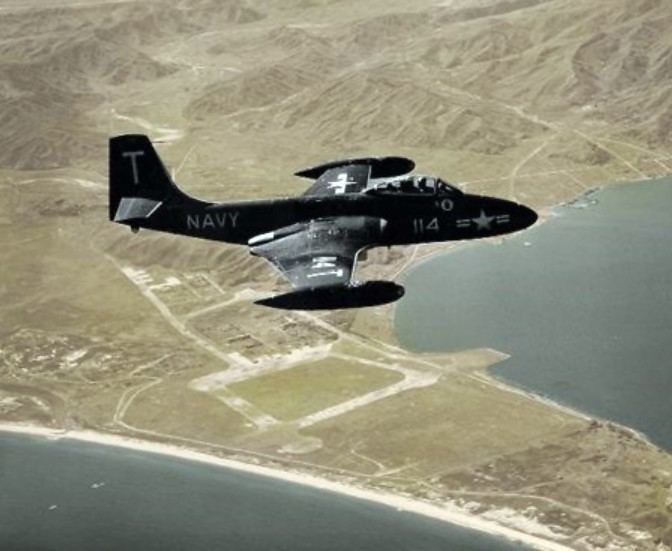 | ||
Engine types Turbojet, Westinghouse J34 | ||
Mcdonnell f2h banshee carrier based jet fighter 1948
The McDonnell F2H Banshee was a single-seat carrier-based jet fighter aircraft deployed by the United States Navy and United States Marine Corps from 1948 to 1961. It was one of the primary American fighters used during the Korean War and was the only jet-powered fighter ever deployed by the Royal Canadian Navy, serving the RCN from 1955 until 1962. The aircraft's name is derived from the banshee of Irish mythology.
Contents
- Mcdonnell f2h banshee carrier based jet fighter 1948
- Meet the mcdonnell f2h banshee us navy jet fighter 1948
- Design and development
- US Navy and Marine Corps
- Royal Canadian Navy
- Variants
- Operators
- Canada
- United States
- Specifications F2H 3
- Popular culture
- References
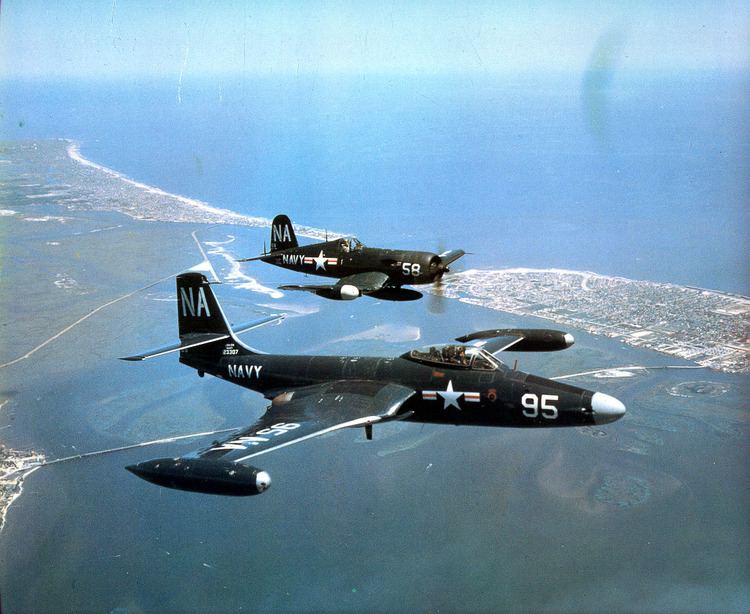
Meet the mcdonnell f2h banshee us navy jet fighter 1948
Design and development
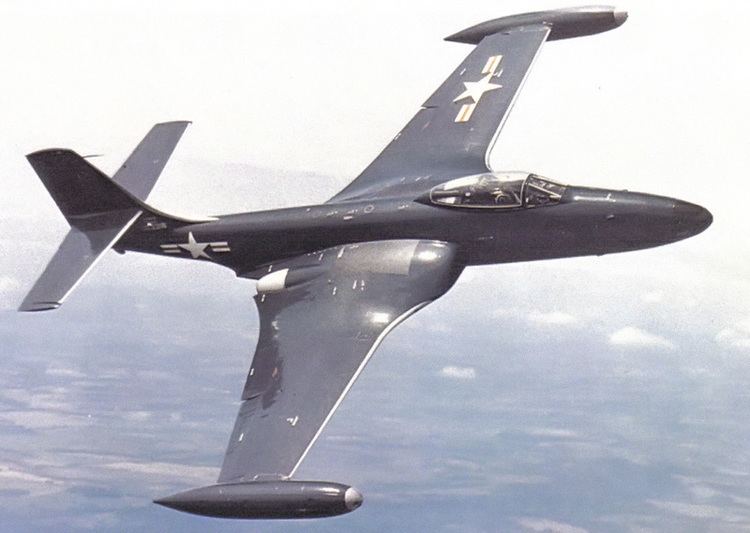
The Banshee was a development of the FH Phantom, although it was being planned before the Phantom went into production. McDonnell engineers originally intended the aircraft to be a modified Phantom that shared many parts with the earlier aircraft, but it soon became clear that the need for heavier armament, greater internal fuel capacity, and other improvements would make the idea unfeasible.
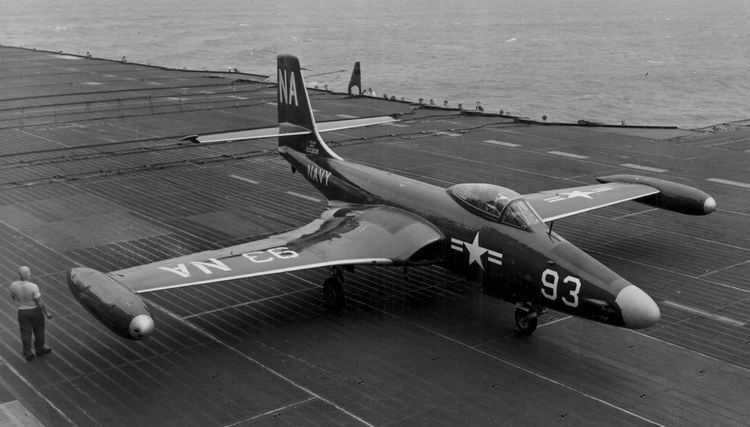
The new aircraft would use much larger and more powerful engines, a pair of newly developed Westinghouse J34 turbojets, raising thrust from the J30's 1,600 lbf (7 kN) to 3,000 lbf (13 kN) each; since the larger engines had to fit within the wing roots, this required a larger and thicker wing with a span of 41 ft 6 in (12.65 m) rather than the Phantom’s span of 40 ft 0 in (12.19 m). The more powerful engines also used more fuel, so the fuselage was enlarged and strengthened to increase fuel capacity. Navy leaders decided to move away from the World War II standard .50-caliber (12.7 mm) machine gun to 20 mm (0.79 in) cannon; four of the guns were mounted low on the nose to prevent pilots from being blinded by muzzle flash when firing the guns at night, a problem that vexed the Phantom with its top-mounted guns. The Banshee was designed to accommodate an ejection seat, a capability the Phantom lacked, and it incorporated a large number of improvements to other aircraft systems. The cockpit was fully pressurized and air-conditioned, and the flaps, landing gear, folding wings, canopy, and air brakes were electrically rather than pneumatically operated. The front of the canopy was made of bulletproof glass that was electrically heated to prevent frost.
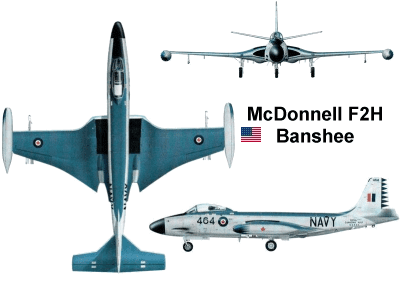
The aircraft incorporated a novel design feature: a “kneeling” nose landing gear consisting of a pair of very small wheels forward of the regular nosewheel. The nosewheel could be retracted so the aircraft rested on the smaller wheels, allowing it to taxi with its tail high in the air. This was intended to ease hangaring by allowing the aircraft to be parked with its nose under the tail of the aircraft ahead, thereby saving space, and to enhance safety by directing the hot jet blast upwards while taxiing. The feature was found to be of little use operationally, however, and was omitted from later Banshee variants.
A mockup of the new fighter, originally designated XF2D-1, was completed in April 1945. The project survived the end of the war, but development work was slowed and the first of three prototypes was not built until late 1946. The aircraft made its maiden flight on the 11 January 1947 from Lambert Field, St. Louis, Missouri. During the first test flight, the aircraft demonstrated a climb rate of 9,000 ft/min (2,743 m/min), twice the climb rate of the F8F Bearcat, the Navy’s primary fleet defense interceptor at the time. The Navy redesignated the aircraft as the XF2H-1 in 1947 after it ordered a different jet fighter from Douglas, another Navy contractor that was also assigned the manufacturer's letter "D". An order for 56 aircraft was placed in May 1947.
Similarities to the FH-1 meant that McDonnell was able to complete the first F2H-1 in August 1948, a mere three months after the last FH-1 rolled off the assembly line. Relative to the XF2D-1, the fuselage was extended about 12 inches forward of the wing and fuel capacity was increased by 29 gallons to 877 gallons. The empennage was slightly redesigned, reducing the size of the vertical tailplane fairing and eliminating dihedral from the horizontal stabilizers. The wing- and tail-thickness ratio was also reduced to increase the critical Mach number. The F2H-1 was retrofitted with 3,150 lbf (14 kN) thrust engines as they became available.
Although the Navy accepted the F2H-1, it was the more capable F2H-2 that was most widely used. With newer Westinghouse J34-WE-34 3,250 lbf (14.5 kN) thrust engines, it had significantly improved performance. The wing was modified and strengthened to add provisions for 200 gal (760 l) wingtip fuel tanks; unlike the contemporary USN F9F Panther, the Banshee's wingtip tanks were detachable. Two armament pylons were added under each stub and outboard wing, for a total of eight, allowing the aircraft to carry a maximum stores load of 1,580 lb (454 kg), consisting of four 250 lb (113 kg) bombs and four 5-in (12.7 cm) unguided rockets. The “kneeling” nose gear was omitted from the F2H-2 and most other subsequent Banshee variants.
The F2H-2 was the foundation for three minor variants of the Banshee. The first, the F2H-2B, had strengthened wings and a strengthened inner pylon under the portside wing to allow the craft to carry a 1,650 lb (748 kg) Mark 7 nuclear bomb or a 3,230 lb (1,465 kg) Mark 8 nuclear bomb. In order to compensate for the vastly increased load, the F2H-2B was fitted with stiffer landing gear struts and a pilot-switchable power booster for the ailerons; the latter was necessary so pilots could control a roll to the left with a heavy Mark 8 nuclear bomb fitted on the left-hand pylon. One 20 mm cannon was omitted to make room for additional electronics to arm the nuclear weapon.
The F2H-2N was a night fighter variant outfitted with a 2 ft 10 in (0.86 m) longer nose that housed a Sperry Corporation AN/APS-19 radar unit. The cannons were moved rearwards in the nose to make room for the radar. One F2H-2N, BuNo 123311, was eventually returned to McDonnell to serve as the prototype for the enlarged and enhanced F2H-3 and F2H-4 series. A handful of F2H-2Ns retained the "kneeling" nose feature of the earlier F2H-1.
The F2H-2P was a photo-reconnaissance version with six cameras housed in a 2 ft 5 in (0.74 m) longer nose; it was the first jet-powered reconnaissance aircraft used by the USN. Remote controls allowed the pilot to rotate the cameras in the vertical and horizontal planes, and the aircraft could be fitted with a pair of underwing pods that each contained 20 flash cartridges for night photography. The camera bay was electrically heated to prevent frost. The F2H-2P was considered a valuable photo-reconnaissance asset due to its long maximum range for a jet aircraft, maximum operational altitude of 48,500 feet, combined with its speed that made it extremely difficult to intercept by other combat jet aircraft of the early 1950s era.
The F2H-3 was the last significant alteration. The fuselage was extended by 8 ft 0 in (2.44 m) to increase internal fuel load to 1,102 gal (4,172 l). The detachable wingtip fuel tanks were reduced in size to 170 gal (644 l) each, but due to the aircraft’s increased internal fuel capacity, these tanks were seldom used in service. The horizontal stabilizers were moved from the vertical tail down to the fuselage and incorporated significant dihedral. The F2H-3 was fitted with a Westinghouse AN/APQ-41 radar unit, enabling the fighter to be used for all-weather missions, and the cannons were moved downwards and rearwards away from the nose to accommodate the radar and increase ammunition capacity from 150 rounds per gun to 220 rounds for each upper gun and 250 rounds for each lower gun. Another four weapons pylons were added under the wings for a total of eight, and the bomb load was increased to 3,000 lb (1,361 kg). The F2H-3 also added provisions for aerial refueling consisting of a bolt-on, readily removable refueling kit that replaced the upper portside cannon with a refueling probe. These changes resulted in a longer, larger airplane that looked significantly different from its predecessors.
The last variant was the F2H-4. It had a Hughes AN/APG-37 radar and slightly more powerful Westinghouse J34-WE-38 3,600 lbf (16 kN) thrust engines that increased top speed by 30 mph (48 km/h) and dramatically increased the aircraft’s service ceiling to 56,000 ft (17,069 m). The F2H-4 was otherwise similar to the F2H-3.
A proposed F2H-3P photo-reconnaissance variant was canceled before reaching production. Unlike many other early jet fighters, no two-seat version was ever produced. A proposal to increase the aircraft’s speed by adding afterburners was canceled after a test aircraft suffered extensive damage to the wing roots and tail structure when the afterburners were actuated. A much faster swept-wing version of the Banshee was canceled before it left the drawing boards.
Production ended on 24 September 1953 after a total of 895 aircraft were delivered. The F2H-3 and F2H-4 were given the new designations F-2C and F-2D respectively under the 1962 unified designation system. The designations F-2A and F-2B presumably referred to the F2H-1 and F2H-2, but these variants had already been withdrawn from service. No Banshees ever flew under the new designations; the last ones in USNR service were placed in storage before the new designations went into effect.
US Navy and Marine Corps
US Navy and Marine pilots often referred to the F2H as the "Banjo".
The F2H-2 served during the Korean War with the US Navy's Task Force 77 and the Marine Corps.
Due to its good performance at high altitude, the F2H-2 initially proved its worth as an escort fighter for USAF bombers, which were supporting United Nations Command (UNC) ground forces.
From mid-1950, the F2H-2 had negligible exposure to hostile aircraft over Korea, due to several factors. During the opening weeks of the war, the North Korean air force was almost completely annihilated by UNC fighter units. From that point onwards, North Korea and its allies were unable to open new airfields near combat zones in South Korea, forcing them to operate out of air bases in China. As a result of their air superiority throughout most of 1950, UNC squadrons were restricted to ground attack missions, especially close air support and interdiction of North Korean army supply lines. In addition, the Banshee, like most jets of its generation, had a serious handicap, relative to the latest fighters: naval air services, including the USN, had resisted faster, swept wing designs – fearing that their characteristics at low speeds would make them unsafe to operate them from aircraft carriers. Consequently, the Banshee was almost 100 mph (160 km/h) slower than the latest fighter designs. The obsolescence of all straight-wing fighters was reinforced by the introduction, in November 1950 of the Mikoyan-Gurevich MiG-15 – often covertly operated by elite Soviet units. Most UNC air combat missions, such as patrols over "MiG Alley", were undertaken by F-86 Sabres of the USAF Far East Air Force. Consequently the F2H-2 operated for virtually the entire war in areas beyond the range of enemy fighters. During the Korean War, Banshee pilots scored no victories in air-to-air combat, nor suffered any losses, although three F2H-2s were lost to anti-aircraft gunfire.
The F2H-2P flew reconnaissance missions during the Korean War, primarily with the USMC. At the time of the war, accurate surface-to-air missiles had not yet been developed and the vast majority of enemy aircraft did not have onboard radar, and AA guns were all but ineffective at fast, high-altitude targets. Air defense tactics still largely depended on being able to see the enemy, and US commanders soon discovered that a lone high-flying F2H-2P was almost impossible for ground forces to spot, much less shoot down. The aircraft was soon in very high demand for the invaluable battlefield photography it could provide. F2H-2Ps even received USAF fighter escorts when operating in areas frequented by enemy fighters. Despite being deployed constantly throughout the war, only two F2H-2Ps were lost to radar-directed AA gunfire, with no air-to-air losses.
The USN deployed the new radar-equipped F2H-3 and F2H-4 for all-weather fleet defense after the conclusion of the Korean War, but only as a stopgap measure until the much faster F9F Cougar, F3H Demon, and F4D Skyray could be deployed in significant numbers. Later variants of the Banshee served for only a few years on the front lines and saw no action. Similarly, the F2H-2P was superseded by the F9F-8P (later RF-9J) variant of the F9F Cougar and the F8U-1P (later RF-8A) variant of the F8U Crusader as these faster aircraft became available.
In 1954, a Banshee flew coast-to-coast, nonstop without refueling, approximately 1,900 miles (3,100 km) from NAS Los Alamitos, California to NAS Cecil Field, Florida, in approximately four hours.
During the Korean War, the US was concerned about a general war in Europe involving the Soviet Union and the total lack of intelligence on that country, in particular the location of airfields. The US Navy devised a plan named "Operation Steve Brody", where four F2H-2P photo reconnaissance Banshees would launch from a carrier cruising on routine maneuvers off the north-east coast of Greece and fly north photographing the land mass of Russia bordering the Black Sea. In May 1952, the U.S. Navy presented the plan to Secretary of Defense Robert Lovett, with the request that he take it to President Harry Truman. Lovett refused, effectively canceling the operation.
Later, in 1955, there was another crisis involving the possible invasion of Taiwan by Communist China. Marine Banshees were chosen for secret overflights of areas where the Communist Chinese would be preparing such an invasion. Unlike the purposed photo-flights over the Soviet Union in 1952, these missions were escorted by other Marine Banshee fighters based in South Korea. Twenty-seven missions took place without incident.
Surviving examples are located on display in private collections and at several naval air stations and marine corps air stations in the United States, including two examples on display at the National Museum of Naval Aviation at Naval Air Station Pensacola, Florida and one example at the Flying Leatherneck Aviation Museum at Marine Corps Air Station Miramar, California.
Royal Canadian Navy
In 1951, the RCN expressed interest in replacing their obsolete Hawker Sea Furies with Banshees, drafting a $40 million deal for 60 new aircraft. Unfortunately, due to fiscal wrangling in the Canadian Cabinet, the purchase was not approved until after Banshee production had been shut down in 1953. The RCN was forced to acquire second-hand USN aircraft, 39 at a cost of $25 million. The aircraft were delivered from 1955 to 1958, and flew from HMCS Bonaventure or as NORAD interceptors from shore bases.
In order to improve the Banshee's capabilities as a long-range interceptor, the RCN equipped the aircraft with the AIM-9 Sidewinder missile. The RCN conducted sea trials of the Sidewinder in November 1959, during which several remotely piloted drone aircraft were shot down.
The Banshee, although initially well liked by its Canadian pilots for its flying qualities, began to suffer from problems in RCN service. A Banshee and its pilot were lost after an inflight structural failure of the folding wing mechanism, and another Banshee suffered an apparent brake failure aboard Bonaventure and rolled off the carrier's deck, falling into the ocean and drowning its pilot. The RCN would eventually lose 12 of its original 39 Banshees to accidents, a loss rate of over 30%.
Utilization of the Banshees fell as the RCN shifted its primary focus to anti-submarine warfare (ASW). Bonaventure was too small to accommodate many Banshees while carrying a sufficient number of CS2F Trackers to conduct around-the-clock ASW patrols, so the carrier frequently left port with no Banshees aboard. Furthermore, the Canadian military was coming under increasing political pressure to cut its budget, and the increasingly obsolescent Banshees were becoming expensive to maintain as years of punishing carrier service and the harsh North Atlantic climate took their toll. The last RCN Banshees were retired without replacement in September 1962. They were the only jet-powered carrier-based fighters ever deployed by the RCN.
Banshees were the primary aircraft of the short-lived RCN Grey Ghosts aerobatic team. The team's name was a play on the Banshee name and the RCN color scheme. The RCN's Banshee fleet was too small to maintain a special contingent of aircraft for airshow service, so the team simply flew whichever active-duty Banshees were available at the time of each show.
Three of the former RCN Banshees survive today but the remaining RCN Banshees were cut up for scrap or destroyed as practice targets.
Variants
Operators
Canada
United States
Specifications (F2H-3)
Data from McDonnell Douglas Aircraft since 1920,Combat Aircraft since 1945 except as noted
General characteristics
Performance
Armament
Popular culture
The aircraft played a central role in the 1953 James A. Michener novel The Bridges at Toko-Ri. The subsequent 1955 movie of the same name used F9F Panthers in place of Banshees for all flight sequences, although parked Banshees are visible in the background of several scenes.
